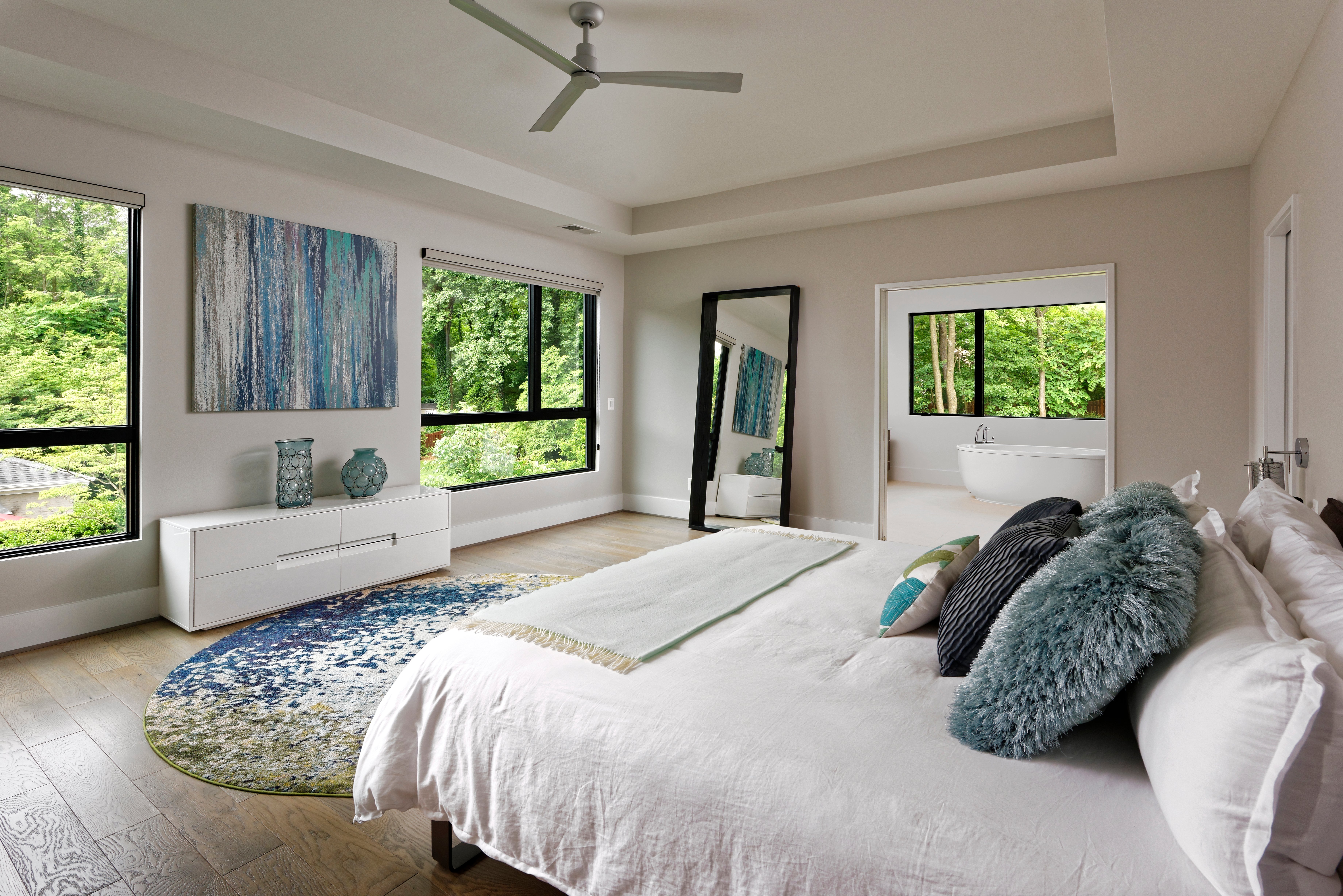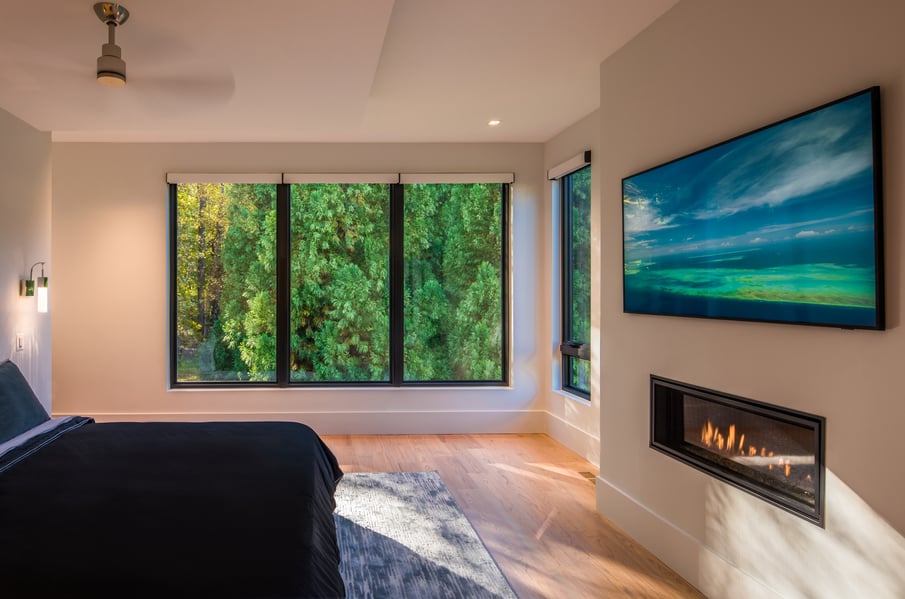
When it comes to designing your dream home, the bedroom — specifically the owner's suite — is one of the most personal and essential spaces to get right. This is the room where you'll unwind after long days, recharge for tomorrow, and find comfort in your own oasis. Designing a bedroom is more than just choosing paint colors or deciding on furniture placement; it requires thoughtful planning to ensure functionality, comfort, and luxury blend together seamlessly.
One key point to remember: the bedroom should be designed in harmony with its adjacent spaces, such as the closets and the bathroom. These interconnected areas will significantly affect how you experience the bedroom. Let's explore the best practices to consider when designing your dream bedroom, ensuring you optimize comfort, privacy, and usability.
1. The Relationship Between the Bedroom, Closets, and Bathroom
When designing your owner's suite, it’s essential to consider the relationship between the bedroom, closets, and bathroom. For most homeowners, the suite is designed to accommodate two people, often with different schedules. That means functionality and privacy are top priorities. The last thing you want is one person disturbing the other while getting up, getting dressed, or preparing for the day.
Strategic Bathroom and Closet Placement
The most effective design ensures that the person who is waking up early can move from the bedroom to the closet and bathroom without disturbing the sleeper. This is why at AV Architects + Builders, we strategically place the closets and bathrooms behind the bed and sleeping area. By creating this separation, one partner can use the bathroom or get dressed without unnecessary noise or interruptions.
There’s a common design mistake out there — putting the bathroom behind the closet, meaning you have to walk through the closet to get to the bathroom. This design flaw is inconvenient and disruptive, especially in a shared suite. It forces the person who’s getting ready to move through multiple areas and possibly wake their partner. The ideal layout keeps these spaces separate but connected in a way that promotes privacy and ease of movement.
Deciding on One or Two Closets
One of the first questions to ask yourself: Do you want two closets or one? For many couples, two separate closets create harmony by allowing each person their own space to organize and store clothing. However, some prefer a large, shared closet. Consider how you and your partner use closet space and decide which option best suits your needs.
 The Hill House, McLean, Virginia, AV Architects + Builders
The Hill House, McLean, Virginia, AV Architects + Builders
2. Considering the Size of the Bedroom
A key mistake people make when designing a bedroom is creating too much unused space. While having a spacious bedroom sounds appealing, in practice, it’s often wasted space. Instead, use that extra square footage to enlarge the closets or bathroom. Believe it or not, no one ever complains about having a bedroom that’s "too small," but people frequently wish their bathroom or closet were larger.
In most cases, if the bedroom is solely for sleeping, you don’t need much additional space beyond what's necessary for the bed and nightstands. However, if you envision a sitting area for reading or a walkout balcony to enjoy morning coffee, then adjust the size of the room accordingly. Our recommendation is always to keep the bedroom functional and cozy, but not too large.
Sitting Areas, Fireplaces, and More
If you do plan to include additional spaces, think about how they’ll fit into the overall layout. For example, a fireplace can serve as a lovely focal point in a bedroom, but where will you place it? Will it compete for space with a TV if you want both? Consider the views as well. Where are the windows, and what kind of light will they let in? Will you have a beautiful view to wake up to, or should the bed be positioned to give you privacy?
These are the kinds of questions you should ask yourself as you create a room that balances relaxation with functionality.
 The Hill House, McLean, Virginia, AV Architects + Builders
The Hill House, McLean, Virginia, AV Architects + Builders
3. Where Should the Bed Go?
Deciding where the bed will be placed is a fundamental step in your bedroom design. The location of the bed influences the entire flow of the room, so it's essential to choose wisely.
Avoiding Plumbing Noise
One major design tip: never put the bathroom directly behind your bed's headboard. If you do, you may find yourself hearing the noise of water lines and plumbing as you try to fall asleep. To prevent this, place the closet between the bedroom and bathroom. This creates a noise buffer while maintaining easy access to both spaces.
Consider Window Placement
In terms of aesthetics and practicality, think about where the windows will be located in relation to the bed. Some homeowners love waking up to natural light, so positioning the bed to face the sunrise may be ideal. In other cases, you may want the bed to face a focal point like a fireplace or TV. The key is ensuring the layout feels balanced and comfortable, with everything in its place.
4. Lighting Design: Keep it Simple
Lighting plays a crucial role in setting the mood of your bedroom. While excessive lighting may seem like a good idea, it can often detract from the serene, peaceful atmosphere you want to create. We recommend keeping the lighting in the bedroom simple.
Subtle Lighting for Relaxation
Consider using wall sconces on either side of the bed for reading, rather than harsh overhead lights. Dimmable lights are also an excellent choice, allowing you to adjust the brightness depending on the time of day or your activity. Keep in mind that in a bedroom, less is more when it comes to lighting. You want to create a cozy, inviting environment, not an overly bright space that feels clinical.
Bright Lighting for Closets and Bathrooms
Where you do want more lighting is in the closets and the bathroom. These are functional spaces where bright, focused lighting is essential. You’ll want to clearly see everything in your closet when getting dressed, and in the bathroom, excellent lighting is critical for tasks like shaving or applying makeup.
 The Solar House, Arlington, Virginia, AV Architects + Builders, Photography by Maxwell Mackenzie
The Solar House, Arlington, Virginia, AV Architects + Builders, Photography by Maxwell Mackenzie
5. Windows, Views, and Privacy
Your bedroom’s windows play a significant role in both the ambiance and functionality of the room. Deciding where to place them can shape how you interact with the space daily.
Privacy vs. Views
The orientation of the bedroom windows will determine how much natural light you get, but also how much privacy you’ll need. Bedrooms don’t need to face south for sunlight; in fact, a northeast or northwest orientation can allow for softer, more indirect light, which many people prefer for sleeping. If your bedroom faces east, you’ll wake up with the sunrise, which could be perfect for early risers.
Motorized Blinds for Convenience
One feature we highly recommend is pre-wiring the room for motorized blinds. Blackout shades are essential for anyone who prefers a dark room for sleeping, and motorized options allow you to control the shades with a remote. With the press of a button, you can open your room to the morning light or shut out the world for a peaceful night’s sleep.
Designing Your Dream Bedroom
In designing your dream bedroom, it’s crucial to focus on the relationships between the bedroom, bathroom, and closet. You want to create a space that not only looks beautiful but also functions seamlessly for your daily routines. Consider the size and layout of the room carefully, ensuring there’s no wasted space. Place your bed in a location that balances privacy and views, and be thoughtful about lighting and window placement.
At AV Architects + Builders, we specialize in designing homes that reflect your lifestyle while offering maximum comfort and luxury. With the right design choices, your bedroom can become the ultimate retreat — a sanctuary within your dream home.
Sofia Alonso is currently the Content Manager at AV Architects + Builders, a family-owned architect-led design-build firm specializing in creating modern style homes for clients in Northern Virginia. Having been with the company since 2019, Sofia has demonstrated a strong commitment to the firm's ethos of providing high-end, luxury living experiences. Sofia holds a Bachelor of Science in Interdisciplinary Studies with a focus on Writing from the University of Virginia. With Sofia contributing to the firm's content strategy, clients can look forward to insightful, educational content that perfectly aligns with the luxurious, high-quality living experiences that AV Architects + Builders is renowned for.
Topics:





